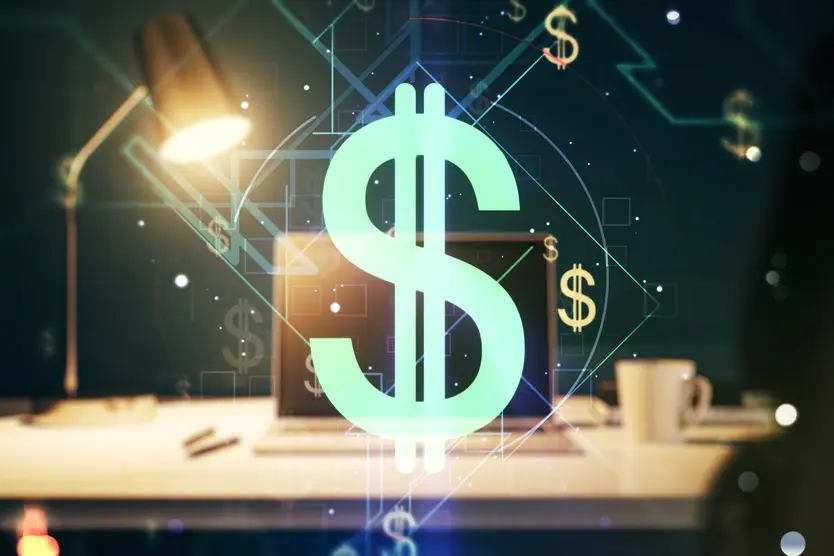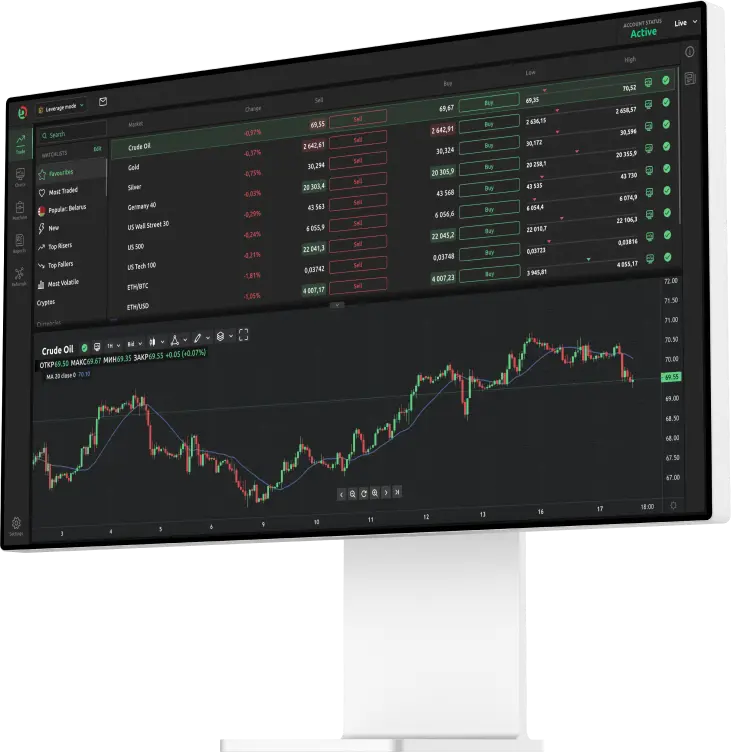With the US economy growing fast and QE taper accelerated, USD forecasts look optimistic

Contents
- USD performance in 2021
- USD forecast 2022
- The Fed and monetary policy
- December Fed update
- US dollar forecast 2022: retail sales grow
- Employment optimism
- ING forecast
- USD forecast for 2022 – Goldman Sachs
- Final thoughts
- FAQs
In the face of soaring inflation and healthy economic expansion, confirmation that bond-buying will be cut by $30bn a month starting January 2022 has imbued confidence in the greenback.
However, with Covid still far from over, and the Omicron variant posing new threats to global economic recovery, the recovery of the dollar in 2022 is far from assured.
Let’s take a closer look at the US dollar news from this year and see where a USD forecast for 2022 could take us.
Before we do this let’s do a quick recap of how the dollar has fared in 2021.
USD performance in 2021
The US dollar gained against the euro in choppy trading earlier in the year. The eurozone currency was trading at $1.23 against the USD at the start of 2021, a two-and-a-half-year high.
The pair fell across the first quarter of 2021, hitting a year-to-date intraday low of $1.17 on 31 March. The euro weakened, and the US dollar performance improved across this period as America ramped up its vaccination drive while the eurozone struggled under its second lockdown and experienced a slow start to its vaccine programme.
From the start of the second quarter, the euro was rising again versus the US dollar, rebounding off $1.17 before running into resistance at $1.23 on 1 June. Rising risk appetite dragged on the USD, boosting the euro during this period. On 19 June, the euro dropped again to $1.19, falling further to a low of $1.17 on 19 August.
In September, the euro made a slight comeback against the dollar, hitting $1.19 on 5 September.
Since, however, the euro has dropped significantly against the USD. On 12 October, the pair hit $1.15, before dropping to $1.12 on 24 November. In early December, the euro made a minor comeback, spiking to $1.13 on 8 December.
This minor rebound may be in part due to the release of the Consumer Price Index (CPI) published on 10 December – reporting a jump of 6.2%, the largest inflation surge in more than 30 years.
Current price of trading pair stands at $1.126.
USD forecast 2022
USD has struggled throughout 2020 and the majority of 2021.
However, with optimistic labour results and an expanding economy, there are a host of factors that could impact a US dollar forecast favourably. However, a combination of Omicron and inflation fears, means uncertainty remains. Let’s take a closer look at some influencing factors.
The Fed and monetary policy
Throughout the pandemic, the Federal Reserve (Fed) has adopted a very lax monetary policy. However, with the Consumer Price Index published in November reporting a jump of 6.2% (the largest inflation surge in more than 30 years) the central bank has been pushed into a quantitative easing taper.
Before getting into recent developments let’s take a look at the monetary policy saga over the last year.
During the worst of the pandemic, the US central bank cut interest rates to a record low of 0% to 0.25% and initiated a quantitative easing programme, buying up $120bn (£89bn) worth of bonds each month. The ultra-loose monetary policy dragged on demand for the US dollar, weakening the currency in 2020.
In early June, the Fed upgraded its growth outlook, announcing that two interest rate rises would likely occur in 2023. In the previous meeting, it had not expected any rate hikes in 2023, instead predicting the first increase in interest rates in 2024. As a result, markets rallied, with the US dollar experiencing its biggest one-day jump since March 2020 on news of the announcement.
In early August, the Fed reiterated that while inflation stays low, interest rates would not be hiked until 2023.
With recent CPI data signalling highest inflation surges in decades, the Fed, however, has since changed its stance.
In response to inflation surge, senior economist Sam Bullard at Wells Fargo told the Reuters news agency: “Supply disruptions and the recovery of services poses a substantial concern that higher-than-expected inflation could persist for longer than the Fed believes.
“We expect goods inflation to hand the baton to services over the course of the next year, but all signs indicate that supply chain bottlenecks will keep fanning the flames on inflation in the near term.”
December Fed update
On 15 December, the Fed issued a statement confirming that, while interest rate hikes would be postponed until labour market conditions “have reached levels consistent with the Committee's assessments of maximum employment”, net asset purchases would be reduced by $20bn for Treasury securities and $10bn for agency mortgage-backed securities per month beginning in January.
This, the statement confirmed, was due to improvements in the labour market combined with the fact inflation has far exceeded the target range of 2%.
Fed chair Jerome Powell in a press conference following the statement said: “Supply and demand imbalances related to the pandemic and the reopening of the economy have continued to contribute to elevated levels of inflation. These problems have been larger and longer-lasting than anticipated, exacerbated by waves of the virus.”
In response to decision to accelerate taper, the Fed’s press statement said: “In assessing the appropriate stance of monetary policy, the Committee will continue to monitor the implications of incoming information for the economic outlook. The Committee would be prepared to adjust the stance of monetary policy as appropriate if risks emerge that could impede the attainment of the Committee's goals”.
Plans to hike interest rates are, while not tied to a specific date, on the horizon. Christopher Waller, a Fed governor and vocal supporter of interest rate rise said a meeting in March could signal the beginning of interest rate hikes. During a two-day committee meeting, most officials pencilled in three-quarter percentage point rate increases, potentially beginning in Spring.
US dollar forecast 2022: retail sales grow
US retail sales for October defied expectations, as reported by the US Commerce Department. Inflation clearly did nothing to keep US shoppers from spending as sales leapt by 1.7%, significantly higher than forecast by analysts.
Comparing October with September, sales rose 2.2% at department stores, 3.8% at electronics and 4% at internet retailers.
While these figures offer good indicators that the US economy is expanding, it is important to note that the higher levels of inflation have a distorting effect on sales figures.
Considering October inflation rose 0.9% in October, nearly half of gains can be put down to rising prices.
Employment optimism
New employment data reported by US Department of Labor in early December indicates a continued labour market recovery.
Unemployment fell by another 0.4% in November bringing the total rate to 4.2%.
The expanding economy, however added an additional 210,000 non-farm payroll jobs. Earnings on average also spiked, with hourly average earnings rising to $31.03 for all workers, an increase of eight cents.
Despite these overall positive results, emergence of Omicron could stunt continued recovery. This in turn could impact the US dollar forecast for 2022.
Andrew Hunter, senior US economist at Capital Economics told Al Jazeera: “The disappointing 210,000 gain in non-farm payrolls in November suggests the labour market recovery was faltering even before the potential impact of the new Omicron variant, possibly as a result of the rising infection rates in the Northeast and Midwest”.
ING forecast
For 2022, ING predicts that European currencies will underperform against the dollar, citing how “all the indicators point to strong US growth in 2022 (near 5%), persistent inflation and a Fed ready for policy rate lift-off”.
ING suggests European currencies have greater vulnerability to supply chain disruption.
The Dutch financial institution argues that the countries that adopt more active approaches to tightening monetary policy will perform the strongest in 2022.
ING EUR/ USD forecast for the first quarter of 2022 is $1.15 before dropping to $1.13 in mid year. By third quarter of 2022, ING predicts trading pair will drop again to $1.11, before dipping to $1.10 by the end of next year.
Trade euro/US dollar – EUR/USD chart
USD forecast for 2022 – Goldman Sachs
In late November, Goldman Sachs amended its three-month forecast for EUR/USD to $1.14 and six-month forecast to $1.16.
In response to their amended USD prediction, the investment bank analysts said: “We would expect markets to remain focused on downside risks to Euro Area activity”.
Trade DXY US Dollar Index – DXY price chart
Final thoughts
Despite continued uncertainty around Omicron variant and continued volatility, there is plenty of reasons for optimism when it comes to the US dollar.
With strong economic recovery on track, monetary tightening to curb dramatic inflation problems and solid employment data, a bullish sentiment for the dollar may potentially continue throughout the new year.
Trade USA 500 – US500 price chart
FAQs
It remains difficult to say what will happen to the US dollar in 2022. The USD remains subject to high levels of volatility. Saying this, both ING and Goldman Sachs give bullish forecasts for the US dollar.
Potentially. Economic recovery is on track and tightening of monetary policy will hopefully imbue renewed confidence in the greenback. However, with inflation a continuing issue and the still unknown impact of Omicron variant, there remains a lot of uncertainty. Remember to do your own research and don’t invest more than you can afford to lose.
USD can be traded at a range of different exchanges, including Dzengi.com. Always remember: your decision to trade depends on your attitude to risk, your expertise in this market, the spread of your investment portfolio and how comfortable you feel about losing money.

